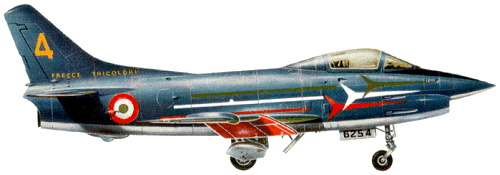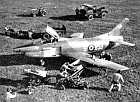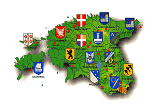Aircraft Profile #119. Fiat G.91 |
|
|
Following the experience gained during the Korean war and the studies made in the light of modern concepts of air co-operation in warfare, SHAPE Headquarters (Supreme Headquarters Allied Powers Europe) envisaged in 1953 the requirement for the adoption by NATO air forces of a light-weight tactical fighter incorporating considerable strike capability, being able to operate at Mach 0.9 at low altitude, and capable of operating from short grass strips and semi-prepared airfields. This requirement was not a simple one to fulfil, a fact which soon became apparent to the selected European manufacturers who were issued the operational specification in the form of a restricted tender. The eight designs submitted to the NATO competition were exhaustively examined by an AGARD (Advisory Group for Aeronautical Research and Development) commission; and finally, on 3rd June 1955 the Fiat G.91 design was chosen as the most promising project, an immediate order for three prototypes and 27 pre-production aircraft being placed. The design was the work of a team headed by Ing. Giuseppe Gabrielli, and in
Within little more than a year of receiving the contract, Fiat translated the basic proposal into a simple and agile aircraft; although in that period the take-off weight had steadily risen over the original figure, owing to the progressive addition of supplementary equipment and the consequential structural strengthening. The empty weight finally stood at a figure 20% in excess of that originally specified. The first of the three prototypes flew at Torino Caselle airfield on 9th August 1956, flown by test pilot Riccardo Bignamini (who, incidentally, had received the McKenna Trophy in the United States in 1955). The aircraft was powered by a 1840kg Bristol Orpheus B.Or.1 turbojet. After a considerable amount of testing, the horizontal control system developed trouble during a high speed level run at 1200m to determine the limit of the aircraft's speed-load envelope, and following a structural failure Bignamini was forced to eject. The tail assembly was immediately submitted to rigorous testing, including evaluation
The identification of the cause of the failure resulted in a certain delay in the test programme and the second prototype flew only in July 1957. It differed in some respects from the first aircraft, the most important of which was the installation of the 2200kg Bristol Orpheus B.Or.3 turbojet. Modifications were also made on the larger tailplane, a higher cockpit (raised by 6cm), and a ventral keel; full armament was fitted. The third aircraft was similar. Basic armament comprised either four 12.7mm machine guns or two 20mm or 30mm cannon in bays in each side of the cockpit plus a wide and varied range of underwing stores. THE G.91 DESCRIBED One of the most important attributes of the G.91 is its short-field capability: the airframe possesses the robustness necessary for high-intensity operation from semi-prepared strips and features ample access panels for simplified field maintenance. The fuselage is essentially conventional and of relatively simple construction: an all-metal semi-monocoque built in three sections. The forward section, (which is built separately and
The centre fuselage houses the seven split fuel tanks which are protected from ground fire along the belly by armour plate. The armament bay, which is formed by the cockpit sides, bulkheads fore and aft, and a horizontal bulkhead top and bottom, is so
The wing, which is swept 37° at quarter-chord, is of laminar-flow aerofoil section with a thickness/chord ratio of 10%. An all-metal two-spar structure is employed, covered by upper and lower skin panels with riveted spanwise stiffeners. The outer panels
The tailplane is of electrically-actuated variable-incidence type; the elevators are fitted with irreversible hydraulic servo-control with artificial feel and two hydraulically actuated door-type air brakes are fitted side-by-side under the centre fuselage, just aft of the wing leading edge. The undercarriage is built by Messier and is intended specifically for operation from unprepared fields, being fitted with low pressure tyres. The nosewheel retracts rearwards under the cockpit while the main wheels retract inwards into a bay in the centre fuselage. A braking parachute is stowed at the base of the rudder. The basic mission of the G.91 is the attack of targets 270km away or less from its base. After take-off the G.91 climbs to 1000m at which altitude it will approach its target at normal cruising speed for 85% of the distance, the remaining 15% being flown at maximum speed.
FIRST OPERATIONAL TRIALS The first pre-production aircraft was flown on February 20th 1958 and in August of the same year, the 103° Gruppo Caccia Tatrici Leggeri (Light Tactical Fighter Group) was formed at Pratica di Mare for operational evaluation of the aircraft and the training of NATO pilots in the ground attack role. A very high training standard was reached in a short time by intensive work on NATO principles. In 1959 this unit was transferred to Frosinone airport, whose infrastructure was really inadequate, without proper runways, and here the G.91's were given for the first time the opportunity to confirm their outstanding capability of operating from every sort of terrain. In the same year the G.91 unit was sent into the Venice area and during the summer a considerable number of exercises were carried out, the
At the same time Fiat developed ground support equipment designed for quick and easy servicing, maintenance and repair of the aircraft on field bases. In accordance with the specific operational task of the light-weight fighter the equipment was designed to minimum size and weight criteria, in order to facilitate its transportation from one semi-prepared ground strip to another, during the movement of the operational bases. This equipment includes: protective and servicing equipment; special periodical inspection and maintenance operation equipment: special tool boxes, tool kits and oxygen system servicing trolleys, bomb and
The G.91 with the solid nose, wings with two pylons, four 12.7mm guns and B.S. Orpheus 801 turbojet was the model produced into an experimental series. In all, with the prototypes, the aircraft for the Aeronautica Militare and the series for NATO, Fiat produced 30 machines of this type, all of them in service with the Reparto Sperimentale di Volo and the 103° Gruppo C.T.L. Following this model, which can be regarded as the tactical aircraft, the R photographic version was produced with a modifield nose housing three Vinten type cameras for forward and lateral oblique photography. With no modification to the armament the G.91R-1 entered series production, twenty five examples being ordered by the Italian Air Force; it has an armament of four 12.7mm Colt Browning machine guns and two underwing stores pylons for two 110kg bombs, two napalm tanks or various combinations of 70mm, 76mm, or 127mm HVAR rockets. A further twenty-five aircraft essentially similar to the previous model but designated G.91R-1A
THE LUFTWAFFE G.91 Germany proved to be the only serious supporter of the G.91 programme and Luftwaffe appreciation of the qualities of the aircraft is proved by the number of G.91’s ordered at various times. The Luftwaffe was originally to have received fifty G.91R and twenty G.91T two-seaters from the Fiat production lines and a further 232 G.91R manufactured under licence in Germany by the Dornier, Messerschmitt and Heinkel companies (Arbeitsgemeinschaft G.91.) The licence production was subsequently increased to 294 aircraft, bringing the total to 344. The variant adopted by the German Air Force was the G.91R-3. This version is similar to the G.9IR-1 apart from certain items of equipment (including a Bendix Doppler and a Computing Devices of Canada Position and Homing Indicator), the provision of four underwing pylons for The first German-built G.91 flew for the first time at Dornier's Oberpfaffenhofen airfield on 20th July, 1961 (with Dornier test pilot Tuytjens at the controls). The Dornier-Werke was responsible for the manufacture of the centre fuselage, the final assembly and flight testing of the aircraft; Messerschmitt contributed the forward fuselage and tail assembly, while the Ernst Heinkel Flugzeugbau was responsible for the complete wing. Each new G.91R-3 was flown for some five to ten hours to check the Doppler, the PHI and other systems before the aircraft was handed over to the Luftwaffe. The Luftwaffe itself received its first two Italian-built G.91R-3's in September 1960. Training courses for the G.91 instructors were initiated by Waffenschule 50 at Erding early in 1961. The first unit to be formed with the G.91R-3 was Aufklärungsgeschwader 53 (53rd Reconnaissance Group), activated temporarily in October 1961 at Erding (near
About the end of May 1962 the 53rd Group began the first operational training flights at Bad Toelz air base, the theme of the excercise being the employment of the new aircraft from semi-prepared terrain with day and night firing and photographic reconnaissance missions. It is worthy of note that from 7th to 11th September 1963 six Fiat G.91R-3's of the 53rd Group took part in a series of air exercises conducted at Rivolto (Udine) air base with the same object, to train German pilots to operate from grass fields. A total of fifty hours were flown by the six German aircraft during this stage. Italian pilots from the 103° and 14° Gruppi also participated as instructors. Two G.91R-3's of the Luftwaffe also performed The extensive utilization of the G.91 by the units of the Italian Air Force and Luftwaffe has evidenced at the same time the peculiar versatility of this aircraft which perfectly fulfills the operational requirements of tactical support and of armed and photographic reconnaissance. The ever-growing and indispensable co-operation between ground forces and air forces has for a long time posed the problem of close tactical support by air. Two essential features were found to guarantee an efficient tactical support: a way to arrest planes safely once they touched down and also a way to get them back into the air. The U.S. Marine Corps, after study and research to solve this important problem, developed a new technique
On the request of the German Air Force the Fiat company completed a study for the application of the hooks to the G.91, for its employment with the catapult. A few G.91R-3's were fitted with this new equipment. SPECIAL TESTS ON THE G.91 At the beginning of 1961 four G.91's were shipped to the United States for a programme of evaluation. Two G.91R-1's were placed at the disposal of technicians of the U.S. Army at Fort Rucker (Alabama) and two G.91R-3's were delivered to the U.S. Air Force at Kirtland base (New Mexico). The aircraft made the transfer flight to the U.S.A. in
Two G.91R-1's were also flown in the United Kingdom by the Bristol Siddeley Company to test directly the performance of the Orpheus engine. OTHER VERSIONS OF THE G.91 The G.91R-4 for the Greek Air Force carries the same armament as the G.91R-1 but features the equipment of the G.91R-3 and has four underwing stores pylons. The delivery of the first Hellenic G.91R-4 took place on 6th September, 1961 at Torino Caselle airport; meanwhile the Service Department of Fiat initiated at Larissa Air Base, upon the request of Hellenic Air Force Headquarters, an instruction course for pilots and specialists on the new aircraft. The programme was never completed. Twenty-five examples each of this version were originally to have been supplied to the Greek and Turkish air forces but neither batch was in fact delivered and the aircraft passed into the Luftwaffe inventory. Several other experimental versions of the basic aircraft have The G.91R-5 was a proposed variant with increased range for Norway and the G.91R-6 an improved model for the Italian Air Force, twenty-five of which were ordered in 1964. The G.91R-6 features a reinforced undercarriage with modified wheels, tubeless tyres, and enlarged air brakes, and was to be equipped with Doppler and Position and Homing Indicator not previously installed in Italian Air Force G.91's. Internal capacity is increased by 5%, a pitch damper is introduced, the electrical and conditioning systems are improved, provision is made for JATO rockets and the underwing pylons are capable of lifting heavier loads and are supplemented by additional wing strong points. THE TWO-SEAT G.91T The Fiat company also developed a tandem two-seat trainer from the G.91R, the G.91T, which may also be used
The G.91T-1 and T-3 differ in equipment, the latter being some 90kg heavier, but both carry a pair of 12.7mm Colt-Browning machine guns and can lift two 220kg bombs, sixty-two 50mm rockets, thirty-eight 70mm rockets or two Nord AS-20 or AS-30 missiles on their two underwing pylons. According to equipment empty weight ranges from 3290kg to 2900kg and loaded weight from 5350kg to 5450kg. Dimensions of the G.91T are the same as the G.91R except for the fuselage which has been lengthened to accommodate the second seat, which is in a higher position than the forward one so that the instructor may easily follow the procedure of the pupil in the
The first batch of G.91T-1's were delivered at the end of 1964 to the Amendola flying school for advanced jet training (Scuola Volo Basico Avanzato Aviogetti): the establishment is now operational for the training of pilots who have completed the course on the Macchi MB.326 jet trainer. An advanced training version with NASARR in the nose, the gun bays occupied by electronic equipment, and similarly positioned instruments to the F-104G was designated G.91T-4 but was never built. Further projected derivatives employing the lengthened fuselage of the G.91T included the G.91/BS.1 single-seat and the BS.2 two-seat battlefield surveillance aircraft and the twin jet G.91Y single-seat long-range strike and reconnaissance aircraft, two prototypes of which are already in production for the Italian Air Force. The Y model will be fitted with two side-by-side General Electric J85 turbojets in place THE G.91 P.A.N. Sixteen of the twenty-seven pre-produetion G.91 strike fighters which served with the 103° Gruppo until replaced by the G.91R have been converted to the G.91 P.A.N. configuration during 1964. The G.91 P.A.N. is a special version for the Pattuglia Aerobatica Nazionale (National Aerobatic Team), which for a number of years used to fly foreign aircraft employed by the Italian Air Force units (such as the F-84 or F-86). In the new G.91 the armament has been removed and replaced by ballast, pitch dampers (the G.91 having only yaw dampers) and special smoke tanks are mounted beneath the wings. The Italian aerobatic team, based at Rivolto (Udine), is a special unit, not dependant on any particular Aerobrigata of the Italian Air Force, being one independent group with its own personnel, pilots and technicians. The team is flying about 1,500 hours per year participating in any air exhibition in Italy or abroad. More than 60% of the exhibitions are performed in the nine jet formation programme. The average efficiency of the aircraft during a 12 months period has been above 90%. (C) Giorgio Apostolo, 1966 |
 All the World's Rotorcraft
|




















